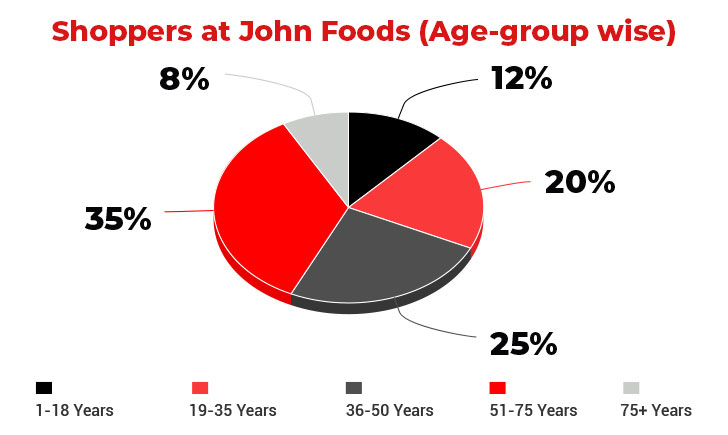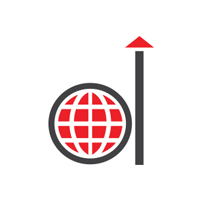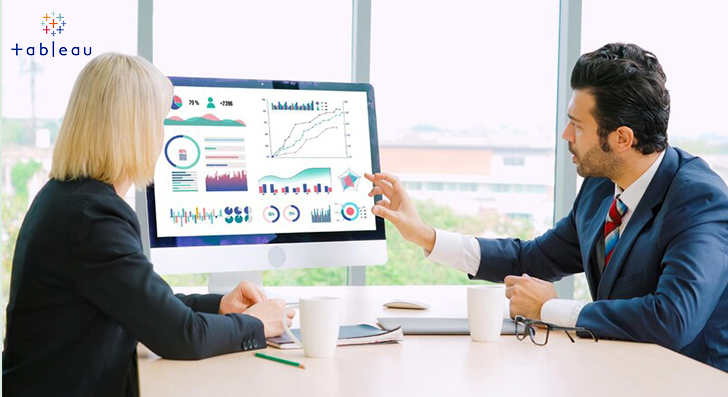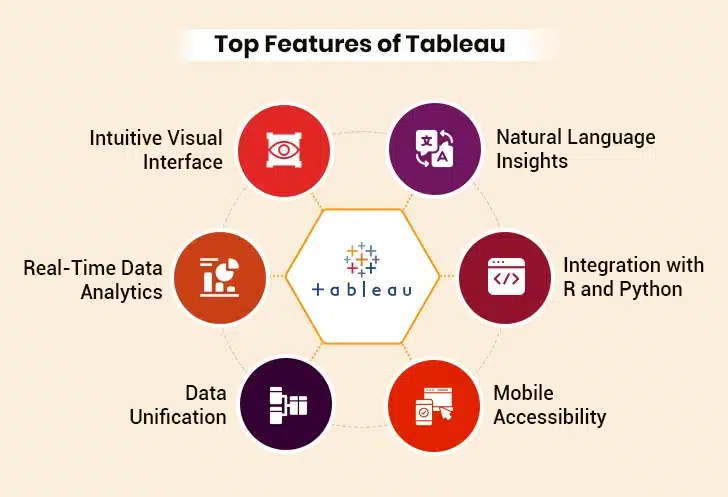Almost every business process, application, and device spews data today, creating an explosion. There’s so much data available that organizations are drowning in it. In other words, data availability is not the challenge, but what’s concerning is its sheer volume, variety, and velocity. Deriving actionable insights from overwhelming amounts of structured, semi-structured, or unstructured data almost instantly is the main challenge. Every business, regardless of its size and spread, requires robust data analytics and visualization tool to turn raw data into strategic intelligence and thrive in the market. Without the ability to harness the full value of data, it becomes more of a burden than benefit for businesses. That’s where Tableau analytics outshines!
Tableau is a visual and intuitive platform for data exploration, analysis, and visualization. Users can explore data, identify trends, uncover patterns, and detect anomalies through interactive visualizations and dashboards offered by Tableau. Its drag-and-drop interface enables users to turn raw data into an understandable format, such as graphs, charts, and other visual elements. In short, Tableau helps businesses “see” and “understand” their data, empowering them to become data driven and drive growth. Better understand Tableau’s transformative power through an illustration.
Table of Contents
Illustrating How Tableau Adds Business Value
Why Businesses Should Invest in Tableau Data
Illustrating How Tableau Adds Business Value
Think of a fictitious business called “John Foods” based in Hampton, Virginia. Launched in 2017, the company initially managed and stored their data and accounting records like invoices and receipts, payroll records, and bank statements in excel files and on the private cloud.
Initial Challenges:
As the business expanded, data volume and complexity also grew, leading to operational bottlenecks and limited visibility into customer behavior. Stakeholders struggled to use data to identify market gaps, make informed decisions and capitalize upon opportunities. Consequently, the company lost prospective customers while another supermarket chain serving the same region performed well. In response to this, the company chose to deploy the Business Intelligence tool “Tableau.”
The Turning Point
The outcomes of implementing were exemplary. Thanks to Tableau’s intuitive dashboards, employees could visualize trends and understand large datasets easily.

To be precise, Tableau’s visualization capabilities empowered stakeholders to identify that the age of their typical shopper ranges from 40-55 years. They used this business intelligence to develop offerings and tailor strategies to target this audience specifically. This boosted sales, led to repeat business, and helped them scale new heights in the industry.
This exemplifies the value of timely insights and Tableau’s ability to deliver them just how the businesses want. This platform is used not only by global enterprises but small and mid-sized firms, across all industries and verticals. Its user-friendly interface makes Tableau a preferred choice for technical and non-technical users. No wonder Tableau remains a leader in Analytics and BI platforms, recognized for the 12th consecutive year! In addition to its exceptional ability to narrate data-driven stories, Tableau offers a plethora of other benefits that cannot be ignored.
Why Businesses Should Invest in Tableau Data Analytics
Whether businesses are looking to identify market gaps to expand paradigms or boost productivity and profits- whatever the case is, Tableau is the right tool to explore, analyze, and visualize data. It turns raw data into powerful visualizations that help make informed decisions and create the right business impact. Still not convinced? Here’s why businesses should invest in Tableau analytics:
1. Analyze Data at the Speed of Thought
Manually pulling data from disparate sources for analysis may take a few hours, days, or even weeks. Another uphill task is to present the resulting insights into visuals that can be understood by decision makers. Thankfully, Tableau’s simple drag-and-drop features and built-in data connections empower users to collect, explore, and visualize data, that too, in real-time. Thus, businesses can identify trends and capitalize upon the passing opportunities.
Make Data Democratization a Reality with Tableau BI
2. Connect with Any Data Source
Another great feature of Tableau is it connects with a variety of data sources, including Microsoft Excel, PDF, Google Sheets, Google Analytics, Dropbox, Salesforce, SAP HANA, and databases, like MongoDB, MySQL, Elasticsearch, etc. By simply connecting Tableau to any data source, businesses can export all the data (without Ctrl C + Ctrl V) for analysis. It is like a bridge that unifies data silos and provides a centralized view, making it easier to query, retrieve, and visualize data. Thus, users can avoid the hassle of going through multiple, disparate reports and still make informed decisions.
3. Integrate with Programming Languages
With the help of Tableau, users can perform basic calculations by simply using the drag-and-drop functionality. However, to go a step ahead and do some complex analysis, Tableau offers various options for integration with Python and R scripting language. Thus, businesses can extend the capabilities of Tableau and use it for more advanced analysis and visualizations. In other words, Tableau is designed to work cohesively with expansive programming languages, offering businesses the flexibility to incorporate custom calculations, advanced analytics, and specialized functionalities into their data workflows.
4. Mobile-Ready Dashboard
Analyzing data on the go was never easier until the arrival of Tableau. This mobile-friendly BI tool allows users to view spreadsheets and data reports across all smartphones, tablets, and laptops. The best part is that users don’t have to do anything to make their dashboards mobile-friendly. Tableau automatically understands on what device it is being accessed and adjusts accordingly.
A Step-by-Step Guide to Tableau Data Visualization
5. Democratization of Data
Tableau stands out in the realm of data analytics for its user-friendly interface. With a minimal learning curve, employees across departments can quickly gain proficiency in creating and interpreting data visualizations. This democratization of data empowers non-technical users to leverage the potential of Tableau data analytics, fostering a more collaborative and data-savvy workforce.
6. Security and Compliance
Security is the key priority for businesses handling critical data. Unlike other data analytics tools, Tableau provides robust security features, including data governance tools, encryption, and role-based access control. This ensures that sensitive business data is protected, and enterprises can maintain compliance with internal policies and industry regulations.
7. Collaborative Decision-Making
Tableau provides a platform where teams can share and discuss insights in real-time, promoting collaborative decision-making. Whether working remotely or in the same office, stakeholders can collaborate on a centralized dashboard, fostering better alignment and communication. This collaborative approach ensures that decisions are based on a holistic understanding of the data.
8. Summarize Key Insights in Natural Language
What makes Tableau a go-to data analytics visualization tool is its ability to summarize key insights clearly and concisely. Businesses can add natural language explanations to dashboards to make them more comprehensible. In case users miss any relevant insights, the tool proactively surfaces them, ensuring they stay on top of the game.
9. Discover the “Why” Behind the Data
Discovering and describing the relationships within data is always time-consuming and challenging. Tableau makes it easier to understand the “why” in data by allowing users to dive deeper into the visualizations. Tableau’s interactive visualizations empower users to explore data in a more engaging and intuitive way.
10. Forecasting and Predictive Modeling
Whether a C-suite executive or a skilled business analyst, Tableau assists anyone to understand data and use it to create a powerful impact. The tool comes with native predictive modeling that helps businesses gain deeper insights into their data and make forecasts, both of which are necessary to remain agile in the competitive markets today.
These are some of the features and benefits of Tableau, all of which collectively make it a powerful data analytics and visualization platform. And to use it more effectively, businesses must follow the tried and tested practices.
Data Visualization Best Practices with Tableau
How to ensure visualizations narrate an interesting story or those are well-received by the target audience? That’s where the tried and tested data visualization best practices with Tableau help. Take a detailed look at these:
Step 1: Select the Right Visuals for the Job
Choosing the right visual, such as graph, bullet charts, histograms, etc., is necessary to tell the best story. After all, one size doesn’t fit all. The visual should answer questions generated by data as that’s the main purpose of this tool.
Step 2: Use Predictable Patterns for Layouts
Humans are visual beings by nature. Eyes quickly catch the attention of indicators that provide important information. Understanding a pattern becomes difficult when it is random or doesn’t make any sense. Based on this human tendency, users must ensure that the visuals representing data must make sense to the viewers, whether sequential, numerical, or alphabetical. This makes it easy to explore data without losing track.
Step 3: Use Color to Narrate Stories Quickly
Visuals are more powerful than words where colors play an important role in conveying the message. However, using color requires a careful balance. For instance, too many shades of a single color may merge the data, whereas too many colors create chaos. It is best to use intuitive colors to help the viewers easily understand the information.
Step 4: Provide Context with Shapes and Designs
Context is the best way to understand the information at first glance. The shapes of subject matter can tell more compelling stories. The relevant silhouettes are far more interesting than plain and bland bar charts, line charts, graphs, or histograms.
Step 5: Include Text Carefully
Lastly, the choice of text, including font size and type, can improve or degrade the visualizations. There are instances where relying solely on visuals doesn’t help; however, too much text can spoil the game. Applying text where it truly matters has a significant impact, even though human brains are trained to process patterns and visuals over words.
Conclusion
Tableau Visualization is a powerful platform that helps businesses understand their data and make informed decisions. It can pull structured, semi-structured, and unstructured data from diverse sources. The collected data is then analyzed and presented in the form of graphs, charts, dashboards, and other powerful visuals that can be understood by humans.
Its drag-and-drop functionality democratizes data, empowering even non-tech users to understand data and make strategic decisions. Businesses, whether startups, small and mid-sized firms, or global corporations, use Tableau to know their data and use it strategically.






